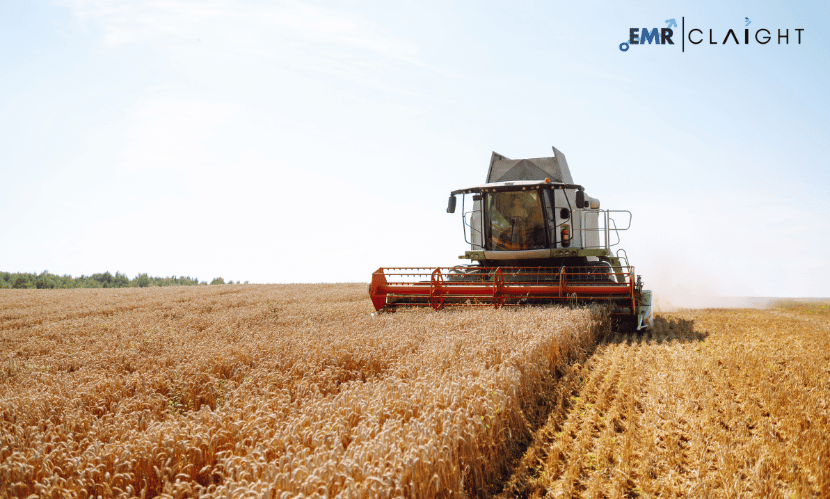The Australia agricultural machinery market is driven by the increasing demand for advanced farming equipment to boost productivity and efficiency. Key factors include the adoption of automation, precision farming technologies, and the need for sustainable farming practices. Tractors, harvesters, and planting equipment dominate the market, with farmers seeking machines that offer higher yields and reduced labor costs. The market is expected to grow as technological innovations and government support for modernizing agriculture gain momentum. Additionally, Australia’s large agricultural sector contributes significantly to the demand for machinery.
Australia Agricultural Machinery Market Size and Growth
The Australia agricultural machinery market, valued at AUD 7.35 billion in 2024, has seen significant growth, driven by the reduction in the need for manual labour. This shift allows farmers to operate more efficiently with fewer workers, effectively lowering operational costs. The growing demand for automation and precision farming solutions, along with support for sustainable agricultural practices, has accelerated the adoption of modern equipment like tractors, harvesters, and planting machinery.
The market is projected to grow at a compound annual growth rate (CAGR) of 6.20% from 2025 to 2034, potentially reaching AUD 13.41 billion by 2034. This expansion is expected to stimulate local manufacturing, enhance trade and export opportunities, and create employment in machinery production and maintenance. As the agriculture sector modernizes, Australia’s agricultural machinery market is set to play a pivotal role in boosting farm productivity and supporting long-term economic growth.
Australia Agricultural Machinery Market Trends
The Australia agricultural machinery market is experiencing several key trends:
Download a Complimentary Sample Report
1. Adoption of Automation and Precision Farming: Farmers are increasingly turning to automated machinery, including GPS-guided tractors, harvesters, and drones, to improve efficiency and reduce labor costs. Precision farming technologies are helping to optimize crop yields and resource usage.
2. Electric and Sustainable Machinery: With growing environmental concerns, there is a shift towards electric and low-emission agricultural machinery. This trend is driven by both government incentives and the need for more sustainable farming practices.
3. Advanced Data Analytics and IoT Integration: The integration of Internet of Things (IoT) devices and data analytics into agricultural equipment is enabling real-time monitoring of machinery performance, soil health, and weather conditions, allowing farmers to make data-driven decisions.
4. Increasing Equipment Size and Efficiency: As farms grow in size, machinery is becoming larger and more capable of handling higher workloads. This trend reflects a focus on increasing productivity while reducing operational costs.
5. Rural-Urban Equipment Distribution: The expansion of machinery sales and service networks into rural areas ensures farmers have access to the latest technologies and maintenance support.
Market Opportunities and Challenges
Opportunities:
1. Technological Advancements: The growing demand for automation, precision farming, and data-driven solutions offers opportunities for manufacturers to develop and deploy advanced agricultural machinery. This includes GPS-guided equipment, drones, and smart sensors, which help farmers increase productivity and reduce operational costs.
2. Sustainability Demand: With increasing focus on sustainability, there is a growing market for electric and low-emission machinery. Government incentives and farmer interest in reducing their environmental footprint present opportunities for innovation in eco-friendly machinery.
3. Export Potential: Australia’s strong agricultural sector provides a robust foundation for agricultural machinery exports. The rising demand for Australian equipment in developing regions and other advanced markets opens significant trade opportunities.
4. Government Support: Government initiatives to modernize the agriculture sector, including grants and incentives for adopting new technologies, support growth in the machinery market.
Challenges:
1. High Initial Costs: The cost of advanced machinery remains a barrier for many farmers, especially small and medium-sized operations. The high upfront cost of automation and precision farming equipment can limit adoption.
2. Labor Shortage: While automation reduces the need for manual labor, the ongoing shortage of skilled workers in the agricultural machinery sector poses challenges in equipment operation, maintenance, and service.
3. Market Competition: The agricultural machinery market in Australia is highly competitive, with both local and international manufacturers vying for market share. This competition can put pressure on margins and limit growth opportunities for smaller players.
4. Maintenance and Repairs: Maintaining and repairing high-tech machinery requires specialized knowledge and parts, which can be costly and challenging to access in remote farming areas.
Australia Agricultural Machinery Market Analysis
The Australia agricultural machinery market is witnessing robust growth driven by the increasing adoption of automation and modern farming practices. Farmers are shifting towards technologically advanced equipment such as GPS-enabled tractors, combine harvesters, and precision seeding tools to enhance productivity and reduce reliance on manual labor. This transition is further supported by the growing need for efficiency in large-scale farming operations and the rising cost of agricultural inputs. The demand for equipment that can optimize input usage and deliver higher yields is shaping the development and sales of machinery across the country.
Moreover, the market is benefiting from government support for agricultural modernization and investment in rural infrastructure. Opportunities are emerging through innovation in electric and low-emission machinery, addressing sustainability concerns. However, challenges persist, including high upfront costs, limited access to skilled labor for operating and maintaining advanced equipment, and logistical issues in reaching remote farming areas. Despite these obstacles, the market outlook remains positive, driven by technology adoption, supportive policies, and Australia’s strong agricultural foundation. The shift towards data-driven and sustainable farming is expected to further accelerate the growth of the agricultural machinery sector in the coming years.
Competitive Landscape
The key players in the industry includes:
- Mahindra Automotive Australia Pty. Ltd.
- John Deere Limited
- Kubota Australia Pty Ltd.
- CLAAS KGaA mbH
- Orbia Advance Corporation S.A.B. de CV (Netafim Ltd.)
- AGCO Corporation
- KUHN SAS
- Daedong Industrial Co. Ltd
- Others
Media Contact
Company Name: Claight Corporation | Expert Market Research
Contact Person: John Walker, Corporate Sales Specialist – Australia
Email: sales@expertmarketresearch.com.au
Toll Free Number: +61 448 06 17 27 | +1-415-325-5166
Address: 63 Fiona Drive, Tamworth, NSW, Australia
Website: https://www.expertmarketresearch.com.au


